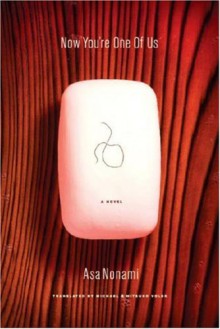
The year is 1931, and the Flying Pussyfoot, a limited express train bound for New York, has just acquired several groups worth of dangerous passengers, nearly all of whom think they'll easily be able to take over the train for their own ends. There's crybaby bootlegger boss Jacuzzi Splot (best name ever) and his misfit band of delinquents, who plan to steal some secret cargo. There's the Lemures group, a bunch of terrorists determined to take some hostages in order to free their leader, the immortal Huey Laforet. There's murder-loving Ladd Russo, the nephew of the head of the Russo mafia family, his bride-to-be Lua, and his group of fellow killers. There's the mysterious monster known as the Rail Tracer. And then there are a few less dangerous passengers, like the thieves Isaac and Miria.
All of these passengers have their own goals and motivations. Only some of them will make it to New York alive.
First, a disclaimer: I have seen (and enjoyed) the anime, which adapted several books in this series, including this one. I suspect it helped my ability to follow along with the characters and story. Normally, I'd suggest watching the anime prior to attempting these light novels, but the anime has gone out of print and, as far as I know, isn't legally streaming anywhere (to anyone who wonders why I still buy so much anime when streaming is an option, this is why).
As far as reading order goes: Although Narita wrote in his afterword that he planned to keep each volume as self-contained as possible, that doesn't mean the books can be read in any order - definitely read Volume 1 before starting this one, even though only a few characters from the first book make appearances in this one. Also, if you make it past Volume 1 and plan on reading Volume 2, you might as well buy Volume 3 as well, because Volume 2 isn't self-contained. It doesn't end in what I'd call a cliffhanger, but it does leave a good chunk of the story untold. Multiple characters show up, only to disappear again, the details of their fates saved for Volume 3.
In my review of the first volume of this series, I wrote that the writing/translation was bad but that this somehow didn't interfere with my enjoyment. That was sadly not the case with Volume 2. I don't know whether it was actually worse than Volume 1 or whether I was just less in the mood, but there were times when the writing literally ground my reading experience to a halt as I tried to figure out what Narita meant. One example:
"Nice objected to that idea. Since she was talking to Nick, even under the circumstances, she meticulously parsed out casual speech and polite speech to the appropriate listener; Nick received the latter." (147)
It would have been simpler to say that, even though she objected to Nick's idea, she still did so politely. Not only is the phrasing incredibly awkward, I'm not sure that "parsed" is the right word here. "Parceled out" might have been more appropriate.
Here's an example that just made me shake my head:
"Without giving an audible answer to that question, Lua nodded silently." (48)
Can we say "redundant"?
As in Volume 1, the writing was almost completely devoid of descriptions. Nearly all of the book's historical and setting details were limited to pages 61 to 62 - otherwise, it was all character introductions, dialogue, and action, pretty much in that order.
It's a sign of how excellent Ladd Russo's English-language voice actor was that I kept hearing him every time I read Ladd's dialogue. Of all of this book's many characters, Ladd and Jacuzzi probably stood out the most. Jacuzzi was a relatively fun and interesting character, a young man who tended to cry and panic about everything but who nonetheless inspired intense loyalty within his group. Ladd, unfortunately, just came across as an excuse for occasional mindless bone-crunching violence.
Isaac and Miria were a disappointment this time around. They continued their role as the series' comic relief, but instead of being oblivious to the violence around them, they were presented as being well aware of what was going on, but so used to it that they were unfazed. Honestly, it made them seem more creepy and disturbing than, say, a more in-your-face monster like Ladd.
I don't expect the series' writing to improve, but I'm hopeful that I'll like Volume 3 more than this one, because all of the fantasy elements that Narita only hinted at in this volume will actually be on-page in that volume. Also, my favorite character from the anime, Claire, will finally get more than just a few vague mentions.
I'll wrap this up with a couple things that made me go WTF. Was the fingernail thing in the anime? I can't remember, but in the book it made me wince. Fingernails don't work like that - I don't care how you shape or cut them, you're not going to be able to saw through multiple ropes with them, and certainly not quickly enough to do any good. Also, if you did arrange to have one of your nails shaped like a tiny saw, you would constantly regret it as you accidentally cut yourself or other people or even just got the nail caught on cloth or whatever. And then there was the thing under Nice's eye patch, which I know was definitely in the anime, although I'd completely forgotten about it. So much wincing. Just a bad, bad idea.
Extras:
Several color illustrations at the front of the book (with text that will likely only confuse readers who haven't yet read the volume and haven't seen the anime), several black-and-white illustrations throughout, and an afterword by the author.
(Original review posted on A Library Girl's Familiar Diversions.)

 Log in with Facebook
Log in with Facebook 









